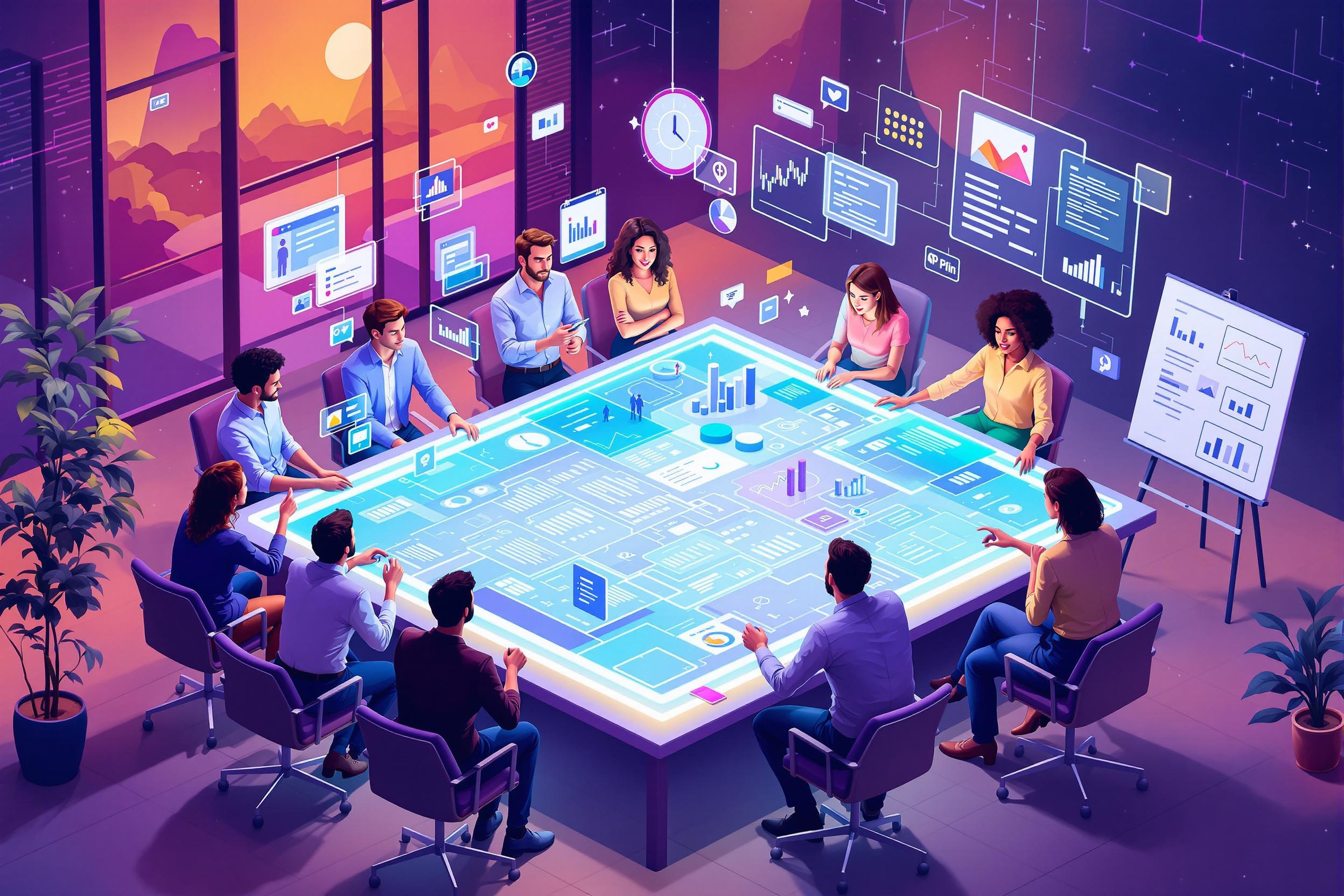Remember when we thought the future would bring us flying cars and robot butlers? Well, here we are, and while my car still stubbornly hugs the pavement, our workplaces have transformed beyond recognition. The rise of AI, automation, and digital everything has flipped the script on what skills employees need. So why are so many companies still training their people like it’s 1999?
I can’t be the only one who’s sat through a soul-numbing PowerPoint training session, wondering if the real lesson is how long I can stay awake. Here’s the kicker: in a rapidly evolving world, outdated training methods don’t just waste time—they actively hinder your team’s ability to adapt and thrive.
So, how do we upskill our teams before the skills gap turns into a skills canyon?
Let’s dive into the messy, exciting, and sometimes absurd world of modern upskilling. Buckle up—it’s time to leave the 90s behind.
The Skills Gap Isn’t Coming—It’s Here
You might’ve heard whispers in the break room: “Tech is changing everything,” or “AI’s gonna take our jobs!” While we can debate the finer points over coffee, the reality is that the skills your team needed five years ago are not the skills they need today.
According to a report by the World Economic Forum, over 50% of all employees will need reskilling by 2025. That’s not a typo. Technology is advancing so rapidly that our collective ability to adapt is being put to the test.
But here’s the wild part: even though the need for upskilling is obvious, many companies are dragging their feet. Maybe it’s the cost, maybe it’s denial, or perhaps they’re just clinging to old habits like a fax machine holding onto its last shred of relevance.
If we don’t address the skills gap now, we’re setting ourselves up for a workforce that’s ill-equipped for the challenges ahead.
Why Traditional Training Is Failing Us
Let’s be honest: traditional training methods are about as effective as trying to download a movie using dial-up. Sure, you might get there eventually, but the world’s moved on, and you’re just left staring at a loading screen.
The classic model—gather everyone in a room, click through slides, maybe throw in a corporate video from the last decade—doesn’t cut it anymore.
- One-Size-Fits-All Doesn’t Fit Anyone: Not all employees have the same needs or learning styles. Forcing everyone through the same generic program is a recipe for disengagement.
- Lack of Engagement: Monotonous lectures and static content fail to capture attention. And let’s face it, if half your team is covertly checking their emails during training, it’s not effective.
- No Real-World Application: Learning in a vacuum without practical context often leads to skills that are forgotten faster than last year’s internet memes.
Time for a Rethink
So, what’s the alternative? How can we inject life, relevance, and actual usefulness into upskilling?
It’s time to get unconventional.
Embrace Microlearning: Snackable Content for Busy Minds
Ever tried to read ‘War and Peace’ in one sitting? Me neither. But we binge-watch entire seasons on Netflix without blinking. What’s the difference? Digestibility and engagement.
Microlearning breaks down complex topics into bite-sized modules that can be consumed on the go. Think short videos, interactive quizzes, quick articles—training that fits into an employee’s daily routine without overwhelming them.
- Flexibility: Employees can learn at their own pace, on their own schedule.
- Retention: Studies show that information is better retained when presented in small, focused segments.
- Relevance: Content can be rapidly updated to reflect the latest trends and technologies.
Microlearning meets employees where they are—in the flow of their work and life.
Gamify or Go Home: Turning Learning into Play
Who says training can’t be fun? By incorporating elements of game design into learning, you make the experience more engaging and motivating.
- Points and Badges: Reward progress to encourage continued participation.
- Leaderboards: Inject a little friendly competition.
- Interactive Challenges: Simulate real-world scenarios that require problem-solving.
When learning feels like play, motivation skyrockets. Employees aren’t just participating because they have to—they’re genuinely invested.
The AI Revolution in Learning: Beyond the Buzzwords
Remember when AI was just a sci-fi dream? Now it’s revolutionizing how we learn and grow. And I’m not talking about chatbots that tell dad jokes (though those are fun too).
Think about Netflix’s recommendation engine. It learns your preferences and serves up shows you’ll love. Now imagine that same personalization power applied to learning. AI-powered learning platforms are doing exactly that - creating unique pathways tailored to each employee’s journey.
I recently spoke with Sarah, a product manager who struggled with data analytics. Through an AI learning platform, she discovered her visual learning style and received customized content that finally made those complex concepts click. “It was like having a personal tutor who really got me,” she shared.
The magic happens when technology adapts to humans, not the other way around.
The Secret Sauce: Learning from Each Other
You know what’s better than one brain? Many brains working together. And I’m not talking about some zombie apocalypse scenario.
Picture this: Maria from engineering has mastered a new programming framework. Instead of keeping that knowledge locked away, she shares it with the team through informal lunch-and-learn sessions. Meanwhile, Tom from sales brings insights from customer interactions that help shape product development.
This organic exchange of knowledge creates a learning ecosystem that’s:
- More engaging than any corporate training manual
- Grounded in real-world experience
- Built on authentic relationships
The best learning often happens in these unscripted moments of connection. It’s like having a brain trust at your fingertips, minus the trust-fall exercises from those awkward team-building events.
When employees teach each other, something magical happens. They don’t just share knowledge - they build bonds that strengthen your entire organization. And unlike that expensive consultant you hired last year, this knowledge sharing comes with a side of genuine workplace camaraderie.
Virtual Reality (VR) and Augmented Reality (AR): Not Just for Gamers
Think VR is only for dodging bullets in dystopian landscapes? Think again. VR and AR are revolutionizing training by offering immersive, hands-on experiences without the logistical constraints.
- Simulate High-Stakes Scenarios: Practice skills in a controlled, risk-free environment.
- Enhanced Engagement: Immersive experiences capture attention like no slide deck ever could.
- Accessibility: With VR headsets becoming more affordable, this tech is no longer out of reach.
Imagine training your sales team with virtual client meetings or teaching safety protocols in a simulated hazardous environment. The possibilities are vast and exciting.
VR and AR bring a level of realism and immersion that can significantly enhance learning outcomes.
Make It Social: The Role of Online Communities
We’ve seen the power of social media in connecting people worldwide. Harness that power internally by creating platforms where employees can share, discuss, and collaborate.
- Internal Forums and Channels: Dedicated spaces for discussing industry trends, sharing articles, and asking questions.
- Social Learning Platforms: Tools that combine learning content with social features like comments, likes, and shares.
- Group Challenges and Hackathons: Team-based events that promote learning and innovation.
When learning becomes a shared journey, it fosters a culture of continuous improvement and camaraderie.
The Leadership Factor: Setting the Tone from the Top
Upskilling isn’t just an HR initiative—it’s a strategic priority that requires buy-in from leadership.
Remember that time your CEO tried to use Snapchat filters in a company meeting? Cringeworthy, yes, but it showed a willingness to embrace new things.
- Lead by Example: When leaders participate in training, it signals its importance.
- Allocate Resources: Invest in the tools and time necessary for effective upskilling.
- Celebrate Learning Achievements: Recognize and reward employees who actively pursue skill development.
A culture that values learning starts with leaders who walk the talk.
Overcoming Resistance: Change Is Hard, but Necessary
Let’s face it: not everyone is thrilled about change. Some employees might be thinking, “I’ve been doing fine for years—why do I need to learn this new stuff?” It’s a fair question.
- Communicate the ‘Why’: Clearly explain the importance of upskilling for both the company and the individual.
- Provide Support: Offer resources and assistance for those who may struggle with new technologies or concepts.
- Create a Safe Environment: Encourage questions and acknowledge that it’s okay not to get it right the first time.
By addressing concerns head-on, you can turn skeptics into advocates.
Measurement Matters: Tracking the Impact of Upskilling
How do you know if your unconventional upskilling efforts are paying off? By setting clear metrics and tracking progress.
- Performance Improvements: Look for increases in productivity, quality, or other relevant KPIs.
- Employee Feedback: Regular surveys can provide insights into how training is perceived and where it can improve.
- Career Progression: Monitor promotions and internal mobility as indicators of skill development.
Data-driven insights ensure that your upskilling strategy is effective and continually improving.
The Risk of Doing Nothing
Picture this: You’re standing at a crossroads. One path leads to transformation and growth, while the other… well, let’s explore that uncomfortable reality.
In my years of consulting, I’ve seen too many companies take the “wait and see” approach. They become the cautionary tales we discuss at industry conferences. Like the manufacturing firm that insisted their legacy systems were “good enough”—until their competitors automated and cut production costs by 40%.
The cost of inaction isn’t just financial. Your top performers, those ambitious individuals who drive innovation, start looking elsewhere when they feel stagnant. They seek companies investing in their future, leaving you with a gradually depleting talent pool.
And perhaps most painfully, opportunities slip through your fingers like sand. That game-changing project you couldn’t bid on because your team lacked the necessary skills? Your competitor just landed it.
The market doesn’t wait for the hesitant, and neither does talent. Every day of delay is a step backward in today’s rapidly evolving landscape.
A Glimpse into the Future: Continuous Learning as the New Normal
In today’s fast-paced world, learning isn’t a one-time event—it’s an ongoing process. The most successful organizations embed continuous learning into their DNA.
- Subscription to Learning Platforms: Give employees access to a wealth of resources they can tap into anytime.
- Regular Learning Sprints: Short, focused periods dedicated to skill development.
- Cultivate Curiosity: Encourage employees to explore topics beyond their immediate roles.
This isn’t just about keeping up; it’s about staying ahead.
Final Thoughts: Don’t Be the Blockbuster of Talent Development
Remember Blockbuster? Exactly. Failing to adapt isn’t just risky—it’s a potential death sentence in today’s dynamic environment.
But here’s the silver lining: by embracing unconventional upskilling strategies, you not only safeguard your company’s future but also create a more engaged, dynamic, and innovative workforce.
So, let’s ditch the outdated training manuals, the one-size-fits-all workshops, and the fear of change. It’s time to upskill or face the skills gap abyss.
Your move. Will you step boldly into the future or cling to the past until it crumbles beneath you?
Feeling inspired (or maybe a little intimidated) by the possibilities? Don’t worry; you’re not alone. Implementing these strategies might seem daunting, but you don’t have to navigate this journey solo.
At Machine Hiring, we’re all about empowering organizations to adapt and thrive. Whether it’s leveraging AI for personalized learning paths or integrating cutting-edge tools into your talent development strategy, we’ve got you covered.
Ready to take the leap? Request a demo and let’s build the future together.
Related Posts
- Employee Well-Being in 2025: Strategies for a Healthier, Happier Workforce
- The Hidden ROI of Employee Onboarding: Why Your First 90 Days Make or Break Success
- Level Up Your Hiring Game: How Gamification is Revolutionizing Talent Acquisition
- Forget Coding—Can You Communicate? Why Soft Skills are the New Hard Skills
- Effective Talent Acquisition Methods: A Strategic Guide for 2025


